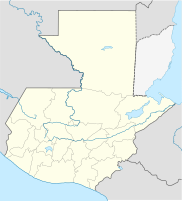Totonicapán
| Totonicapán | ||
|---|---|---|
|
Coordinates: 14 ° 55 ′ N , 91 ° 22 ′ W Totonicapán on the map of Guatemala
|
||
| Basic data | ||
| Country | Guatemala | |
| Department | Totonicapán | |
| City foundation | Pre-Columbian | |
| Residents | 60,000 | |
| Detailed data | ||
| height | 2495 m | |
| Waters | Hot water springs | |
| Time zone | UTC −6 | |
| City patron | Michael (Archangel) | |
Totonicapán (also San Miguel Totonicapán ) is a city in Guatemala with almost 60,000 inhabitants . It is the administrative seat of the Totonicapán Department and the municipality of the same name .
Location and climate
The city is located 204 km northwest of Guatemala City and about 30 km northeast of Quetzaltenango in the highlands of the Sierra Madre at an altitude of 2,495 m. You can reach Totonicapán from Guatemala City on the Interamericana (CA 1). Shortly before Quetzaltenango, at Cuatro Caminos, the 12 km long road to Totonicapán branches off in an easterly direction. The climate in the city and the surrounding area is cold.
Economy and tourism
Totonicapán is known for its handicrafts and for its small textile companies.
There are several hot water springs in the valley between Cuatro Caminos and Totonicpán and in the vicinity of the city. The only sights in the city are the neoclassical theater , which opened in 1924, and the San Miguel Arcángel Church, consecrated by Bishop Francisco Marroquín in 1545 , which had to be rebuilt several times after the earthquake, most recently in 1878. On the western outskirts is the Tanque de Los Dragones , one of four Well fed by dragon mouths and washing area. Totonicapán is known for numerous colorful festivals, including the dance festival in spring, the independence celebrations on September 14th and 15th and the celebration in honor of the patron saint Michael .
history
Before the arrival of the Spaniards, Totonicapán was the second most important place of the Quiché after Utatlán under the name Chuimekenhá ( Eng . "Above the hot springs") . The Mexican mercenaries settled here by the Spaniards gave the place the synonymous name Totonicapán. Silver was mined during the colonial period . The Quiché rebelled again and again against the Spanish colonial rulers. In 1816 Totonicapán's mayor Atanasio Tzul refused to pay taxes to the Spanish crown. In 1820 Anastasio Tzul organized an uprising that initially drove the colonial rulers out of the city. Anastasio Tzul was crowned King of the Quiché, but his term of office lasted only 29 days: Spanish troops from Quetzaltenango arrested Tzul and his colleagues. The celebrations that take place in Totonicapán today on the eve of the official independence day (September 15) are dedicated to the Quiché folk hero Anastasio Tzul, who has also been memorialized in the city. After independence from Spain (1821), Totonicapán became the capital of the department of the same name in October 1825.
See also
Individual evidence
- ^ John Baily: Central America; Describing Each of the States of Guatemala, Honduras, Salvador, Nicaragua, and Costa Rica . Trelawney Saunders, London 1850, p. 85.
